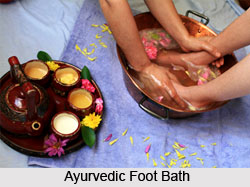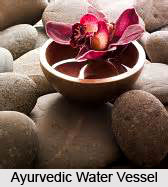 Water represents soma that has cooling and nourishing properties and associated with lunar energy. Ayurveda, the ancient science encompasses the well being of mankind through a series of scientific system of diet, healing and health maintenance. Reckoned as a holistic treatment procedure Ayurveda is deeply spiritual and is just not a type of treatment, but a philosophy, which ideally combines science and celestial understanding to make life a lot better. According to Ayurveda, water is one of the important components of the five fundamental elements or Panchabhuta.
Water represents soma that has cooling and nourishing properties and associated with lunar energy. Ayurveda, the ancient science encompasses the well being of mankind through a series of scientific system of diet, healing and health maintenance. Reckoned as a holistic treatment procedure Ayurveda is deeply spiritual and is just not a type of treatment, but a philosophy, which ideally combines science and celestial understanding to make life a lot better. According to Ayurveda, water is one of the important components of the five fundamental elements or Panchabhuta.
Ayurvedic texts describe a number of water types. Each type of water has its own therapeutic value. Water represents soma that has cooling and nourishing properties and associated with lunar energy. It helps in digestion, cools and balances Pitta dosha, counteracts the dryness caused by Vata Dosha and supports Kapha. When water flows out of the body in the form of urine, it nurtures, lubricates and detoxifies the body. Water gives several healing properties when it is properly absorbed by the body.
The beneficial effects of waters are-it helps to remove fatigue (shramnasana), enhances glow of skin, removes constipation, increase stamina, helps in digestion, maintains the proper functioning of heart, assist in cooling of the body, it provides satisfaction, water is easy to assimilate, it acts as antioxidant. Water is considered as a life-giving element. The healing effect of water can be enhanced by using Ayurvedic methods.
Sometimes people have very dry skin and though they drink a lot of water they have unquenchable thirst. Their deeper physiology does not get enough moisture. This situation occurs when the concerned person`s Agni is low and mucus blocks the micro-channels that carry water to the cells. In order to cleanse the channels and enhance the moisture absorption water is boiled for various lengths of time. This therapeutic water is called ushnodaka. The other method involves adding spices or herbs to the water after boiling.
When the water is boiled it gets charged with heat hence become sharper in quality. The sharpness allows cleansing the channels and penetrating deeper levels in human body. The spices added to the water gives an extra-therapeutic effect since it interacts with the water in molecular level. The aroma and taste of the spice creates different effects on the body.
 The body can flush out toxins and impurities because of the sharpness of agni(heat) in the water. The sharpness of the spices also helps in this. Over time the hot water cleanses the channels so that the water is unobstructed as it travels within the body to hydrate the tissues and takes away the waste material of the body.
The body can flush out toxins and impurities because of the sharpness of agni(heat) in the water. The sharpness of the spices also helps in this. Over time the hot water cleanses the channels so that the water is unobstructed as it travels within the body to hydrate the tissues and takes away the waste material of the body.
In ancient texts the difference in the rate of absorption of regular water and boiled water are mentioned. Regular water takes around six hours to get absorbed if all the channels are cleared. The boiled and cooled water takes about three hours to be absorbed and helps to open channels. Hot herbalized water takes about one and a half hours to be absorbed because of the sharpness of Agni, herbs and spices.
An Ayurvedic expert can prepare the specific recipe of therapeutic water to give a specific benefit. While, one type of water increases immunity power; another type supports in cleansing the skin, or often to cure the prostate problem. Ayurveda, with its wide array of spice water recipe therefore offers one the choice to opt the right kind of water type depending on the body category and of course on the types of imbalance.
Vata Balancing Water
Two quarts of water is boiled for 5 minutes. Now this is taken off the heat and three mint leaves, half-teaspoon ajwain or Bishop`s weed and quarter tea-spoon of singhada flour are added to it. The water is then placed in a thermos. It should be sipped throughout the day at a warm but not hot temperature.
Pitta Balancing Water
Two quarts of water is boiled for two minutes. It is taken off the heat and one quarter spoon of ajwain, 2 rose buds and 1 clove are added to it. It is also stored in hot inside a thermos. Before drinking it should be poured in a cup and then it should be let cool to room temperature in summer and in winter the water can be slightly warmer.
Kapha Balancing Water
Two quarts of water is boiled for five minutes. It is then taken out off heat. Three basil leaves (Tulsi), two thin slices of fresh ginger, one quarter teaspoon of cumin and half teaspoon of ajwain. The water and the spices are then placed in the thermos and water is taken by sipping at a hot or warm temperature throughout the day.
Ayurveda recommends on the quantity of water that one should drink. The amount of water one should drink depends on the age, how much exercise or physical work one does, the weather, the diet, stress levels, herbal food supplements and the body type. The persons with warm Pitta type are usually thirstier than those who have watery Kapha type of body. The people with Vata type have often problems of constipation and dry skin and they need to drink more water.
The Ayurveda recommends making the spice water first in the morning and sipping it in every fifteen minutes throughout the day. Plain water should be consumed after seven o` clock at night since spice-water is too invigorating to drink before sleeping. If the spice water is not finished by the evening, it should be thrown away and fresh start should be done from the next morning.
Some people might want to drink plain water during the day also. If an individual performs exercise and wants to drink a glass of water, its better to drink plain water rather than spice water.





